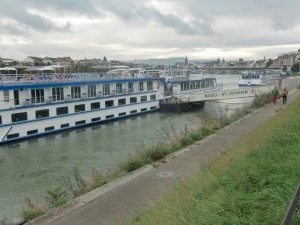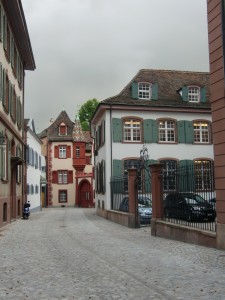CRUISING THE RHINE AND MOSEL RIVERS – A BEGINNING AT BASEL
CRUISING THE RHINE AND MOSEL RIVERS
This is the first in a series of articles about cruising the Rhine and Mosel Rivers
A BEGINNING AT BASEL
By Charles N. Stevens
Photos by Dolores Seidman
The Lufthansa flight from Los Angeles to Frankfurt, Germany is incredibly long. Being cooped up in a small space for that much time confines the soul, but the food and drink service is quite good and so is the availability of movies on individual screens.
The sprawling Frankfurt airport is a baffling maze, the tourist walking forever to get from one gate to another. The airport is so extensive and the frequency of flights so great that they don’t have enough gates in the terminal. We wait in a lounge for a bus to take us about a mile out into a distant flight line to board a smaller jet for the forty minute flight to Basel, Switzerland. As we step off of the bus and ascend stairs into the plane, the cabin attendant hands each of us a crunchy chocolate bar.
As the plane descends into the airport, we can see that Basel is not a quaint Swiss town, but a large city of old and new buildings, industrial plants with steam rolling out of tall stacks and vast railroad yards. From the airport a bus transports us to the ship docked on the Rhine River, a welcome sight after such a tiring trip. Weary, we organize our luggage in our comfortable cabin then indulge in an hour’s nap. Ah to rest our bones after the grueling journey!
After waking, we admire the view from our cabin window, the wide Rhine flowing silently northward from the Alps. Buildings on the opposite shore are modern with a few of the older ones mixed with them. Streetcars pass across a bridge spanning the river while a small funky ferry boat attached to a long aerial cable uses the power of the flowing river to make its way across. The scene is vastly different from home, so stimulating and exciting. That is why we travel.
We are presented with a lovely dinner featuring beef roulade, but we are so tired that we can’t savor it. Finally we are in bed for a glorious sleep and the renewing of our bodies.
* * *
We wake up refreshed the following morning, the skies cloudy, lights reflected on the water. I gaze out at the Rhine, amazed about how fast it is flowing. A long barge passes us, churning the water with its bow as white gulls fly low over the river.
After a hearty breakfast served as a buffet with endless choices, we leave with our group for a walking tour of Basel. We’re bundled up against the cold morning, the temperature in the 40s. Our first adventure of the day is to board a street car that will whisk us into the center of town, just a few miles away. The ride is smooth, fast and comfortable as we zip through the nearly empty streets, people preferring to use the trolleys rather than drive their cars. The Swiss have perfected their network of trolley routes to cover the entire city.
In town we depart the warm atmosphere of the trolley and once again step into the cold, the temperature 42 degrees. We walk through narrow streets to the thousand year old Basel Munster, a former Catholic cathedral that became Protestant when the Swiss turned to that religion. We stand among its gothic cloisters with their filigreed arches, then look out on its colorful tiled roof and the flying buttresses that support the main sanctuary. Tombstones hang on the wall. The place is stony, cold and shadowy, matching the cloudy chill of the morning.
Moving on to a small park-like area on a bluff behind the church is a relief from the dankness of the cloisters. From here we can look out over the Rhine, an off-color green under the dull sky, and a vast panorama of Basel. Chestnut trees are dropping their leaves here, the brittle brown accumulation littering the ground. At a distance a green trolley roars over a bridge, tall cranes attest to the developing city, and a tall glass hotel dominates the skyline.
Walking through the crackle of dead leaves, we move on to the Munsterplatz, a vast plaza lined with old three and four story houses or apartments with steep pitched roofs. At the end of a narrow street leading off of it is a stand selling roasted chestnuts, steam rising from them, a bit of warmth in the chilly day.
Finally we arrive at the Market Square or Marktplatz dominated by the 500 year-old Town Hall or Rathaus, an imposing brick-red building painted with figures and scenes and topped with an ornate golden tower. We also walk into its courtyard with its arches, statues and gold.
We casually stroll around the market place looking at the goods for sale at the stands. We pass beautiful bouquets and vases of golden sunflowers, a variety of cheeses, giant mushrooms, honey, gorgeous looking fruits and vegetables, everything rather expensive. A small basket of strawberries is $8 and an “American hot dog” $7. Bakeries and butcher shops offer a tempting variety of breads and meats. We walk among strings of salamis and glass vats of all kinds of olives then admire a huge wheel of Gruyere cheese.
Numb with the cold by now, we walk across the street to the Globus Department Store for a bit of warmth. The merchandise is all very attractive and displayed beautifully with lots of color and light, but very expensive. The Swiss Franc is nearly even with the U. S. dollar, so it is easy to compare prices. A small tray of sushi is priced at16.90 francs.
Hungry after our walk through the temptations of the market place, we board a streetcar to return to our ship and a nice warm lunch.
Captions:

We leave our ship on a cold, cloudy morning for a walking tour of Basel.

The trolley system in Basel covers every part of town. We are about to board one to take us into the town's center.

Not far from the Basel Munster are cobblestone streets and two and three story buildings with peaked roofs.

Amazing is Basel's Town Hall or Rathaus of vibrant brick red sandstone and golden towers.
MONTEREY PARK AUTHOR PUBLISHES 3RD BOOK ABOUT HIS EXPERIENCES IN WORLD WAR II- BACK FROM COMBAT
Charles “Norm” Stevens, a 40 year resident of Monterey Park and World War II Veteran has recently published the 3rd in his series about his experiences in WW II, Back from Combat: A WWII Bombardier Faces His Military Future. This book details the time from when he returned from combat in England where he flew 34 missions over Germany and France until the end of the war. Faced with large numbers of returning combat vets, and not knowing how long the war would continue, the military had to plan for their future. His options were whether to return to combat, become an instructor in the U.S., or receive new training that he would use in the Pacific. The book concludes with the end of the war with an Afterward that includes an update on the B-l7’s still flying in the U.S., as well as present day accounts pertaining to the war.
Stevens is the author of two previous books about his experiences:
An Innocent at Polebrook: A Memoir of an 8th Air Force Bombardier (Story of his 34 bombing missions from his base at Polebrook, England over Germany and France)
The Innocent Cadet: Becoming A World War II Bombardier (A prequel to the first, telling of his training in the U.S. before going overseas into combat.)
He is known to the readers of The Citizen’s Voice as the author of Travel Log Articles including “From Paris to Normandy on the Seine”, “Exploring New York” and “In Search of Snow.” He is retired, having taught for 32 years, primarily in the Montebello Unified School District.
Those interested in purchasing an autographed copy of any of his books, may contact the author at 323-721-8230 or Normstevens24@gmail.com.



